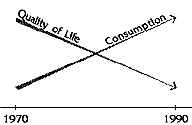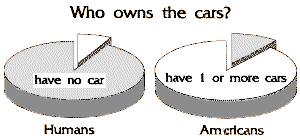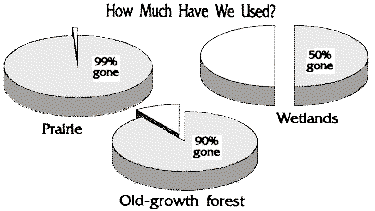 From EcoFuture ™
From EcoFuture ™
 From EcoFuture ™
From EcoFuture ™
Yet amidst this affluence is evidence of a different story. Our rising standard of living has not always resulted in a higher quality of life. Indeed, in many ways there has been an erosion in our sense of well-being -- both for us as individuals and for us as a people. Our wealth has come with unforeseen costs: personal, social and environmental.
The following statistics, compiled by the New Road Map Foundation, tell the story of how our patterns of consumption affect our personal lives, the lives of other human beings and the environment. They also show the hopeful beginnings of a new frugality movement: a cultural trend toward "low-consumption, high-fulfillment" lifestyles.
The New Road Map Foundation (NRM) is dedicated to lowering consumption in North America. Their primary tool for teaching people how to painlessly consume less while increasing their quality of life is the book, Your Money or Your Life by Joe Dominguez and Vicki Robin, founders of NRM. The Foundation is staffed entirely by volunteers and donates all proceeds from educational programs to projects promoting a sustainable future for our world.
Go to: Solutions, End, or EcoFuture Home
Americans reporting that they were "very happy" were no more numerous in 1991 than in 1957. [2]
Percentage of 18 to 29 year-olds who think they have
a very good chance of achieving "the good life":
1978: 41%
1993: 21 % [3]
Rise in per capita consumption in the U.S. in the last 20 years: 45% [4]
Decrease in quality of life in the U.S. since 1970, as measured by the index of Social Health: 51% [5]

Percentage of Americans who feel the American Dream is very much alive:
1986: 32%
1990: 23% [6]
Compared to their parents in 1950, people in the U.S. in 1991
owned twice as many cars and drove 2.5 times as far. [8]
Amount of time the average working American spent behind the wheel in 1991: 9 hours per week [9]
Increase in average daily TV viewing since 1960: 39% [10]
American parents spent 40% less time with their children in 1991 than they did in 1965. [11]
Employed Americans spent 163 hours more per year on the job in 1991 than they did in 1969. [12]
Percentage of college freshmen who reported thinking it is essential to be well off financially:
1967: 44%
1987: 76%
Percentage of college freshmen who reported thinking it is essential to develop a philosophy of life:
1967: 83%
1987: 39% [13]
Median size of a new house built in the U.S.:
1949: 1,100 sq ft [14]
1970: 1,385 sq ft [15]
1993: 2,060 sq ft [16]
Residential space per American:
1950: 312 sq ft
1993: 742 sq ft [17]
Number of Americans with two or more homes in 1991: 10 million
Number of homeless Americans in 1991:
a minimum of 300,000 [16]
Amount of time the average American will spend
watching TV commercials: one entire year of his or her life [20]

Percentage of American teenage girls who report
store-hopping as favorite activity: 93% [21]
Year in which the number of shopping centers in the U.S. (32,563)
surpassed the number of high schools: 1987 [22]
Average time spent shopping per week: 6 hours
Time spent playing with children per week: 40 minutes [23]
About 53% of grocery and 47% of hardware store purchases are spur of the moment. [24]
Percentage of shoppers surveyed across the country who were
shopping for a specific item: only 25% [25]
Americans can choose from:
over 25,000 supermarket items
200 kinds of cereal
11,092 magazines [26]

By the time a baby born the United States reaches age 75, he or she will have
produced 52 tons of garbage,
consumed 43 million gallons of water
and used 3,375 barrels of oil. [28]

Proportion of houseware bought to replace worn-out items:
1981: 2/3 to 3/4
1987: less than 1/2 [29]
For packaging (cans, bottles, cartons, etc.) alone, the U.S. uses approximately:
50% of its paper
75% of its glass
40% of its aluminum and
30% of its plastics. [30]
Amount of motor oil sent to landfills or poured down drains in the U.S. each year:
180 million gallons -- the equivalent of 16 Exxon Valdez spills. [31]
Highest income group in U.S.: doctors [33]
Professions with highest proportion of unhappy people: doctors and lawyers [34]
Percentage of American workers who report feeling "used up" by the end of the workday: 42% [35]
Percentage of women who said "enough money" would persuade them to stop working permanently:
1987: 35%
1990: 56% [36]
(Presumably both men and women are also interested in putting in less time and taking less money, as semi-retired people choose to do)
Percentage of Americans who would like to "slow down and live a more relaxed life": 69%
Percentage of Americans who would like a "more exciting, faster-paced life": 19% [37]
The amount of energy used by one American is equivalent to that used by:
3 Japanese
6 Mexicans
14 Chinese
38 Indians
168 Bengalis
531 Ethiopians [39]
A person in the U.S. causes 100 times more damage to the global environment
than a person in a poor country. [40]
Percentage of fossil fuel used annually that is consumed by the U.S.: 25% [41]
Percentage of all humans who own a car: 8% [42]
Percentage of American households who own one or more cars: 89% [43]

Average annual income of the 3.3 billion people in the global "middle class": $700 - $7,500
Average annual income of the 1.1 billion people in the global "consumer class": over $7,500
The consumer class takes home 64% of the world's income. [44]
The average amount of pocket money for American children
-- $230 a year --
is more than the total annual income of the world's half-billion poorest people. [45]
In the last 200 years the United States has lost:
50% of its wetlands
90% of its northwestern old-growth forests
99% of its tall grass prairie and
up to 490 species of native plants and animals
with another 9,000 now at risk [48]

Minerals due to run out in 50 years: copper, lead, mercury, nickel, tin and zinc [49]
Portion of U.S. water pumped annually from the groundwater supply that is not renewable: one-fifth [50]
Amount of rural land in the United States turned over to development every day: 9 square miles [51]
Number of acres we blacktop each year:
1.3 million acres (equal to the state of Delaware) [52]

Number of acres of cropland we lose to erosion each year: 1 million [53]
Per capita American consumption of soft drinks in 1989: 186 quarts
Per capita American consumption of tap water in 1989: 149 quarts [54]
Total energy consumed in producing a 12-ounce can of diet soda: 2,200 Calories
Total food energy in a 12-ounce can of diet soda: 1 Calorie [55]
Within the lifetime of a child born today, virtually all of Earth's petroleum will be burned,
and Earth' s fuel tank will be empty. [56]
Percentage of disposable personal income in U.S. allotted to savings:
1973: 8.6% [58]
1993: 4.2% [59]
Percentage of disposable income spent on personal debt payments:
1983: 8.6%
1990: 83% [60]
An American baby born in 1992 inherited a portion of the U.S. government debt equal to: $14,813. That portion continues to grow each year. [61]

Average increase in consumer spending when credit cards are used instead of cash: 23% [62]
Increase in consumer debt in the 1980s: 140% [63]
The typical American household carries $8,570 of non-mortgage personal debt. [64]
Number of individuals filing for bankruptcy in 1992:
900,000 -- triple that of 1981 [65]
8 out of 10 Americans regarded themselves as "environmentalists" and
half of those said they were "strong" ones.
o
8 out of 10 voters said protecting the environment is generally
more important than keeping prices down.
o
53% said it will take fundamental changes in lifestyle, rather than scientific advances,
to bring about dramatic changes in the environment.
o
BUT ... Only 46% surveyed said they had actually bought any items based on the environmental reputation of a product or manufacturer within the last 6 months.
o
AND ... By 51% to 34%, voters thought the need to protect jobs in the U.S. Northwest
was more important than the need
to protect the endangered spotted owl, an indicator species linked to healthy forests.
FURTHER ... In 1990 American households had between 50 and 100 pounds of hazardous material that should be disposed of only through recycling or professional waste collection. In 1989, 628 communities across the U.S. had programs to collect hazardous waste.
In 1990, only 1% to 5% of the residents used these programs. [67]
Percentage of Americans in 1990 who believed that a
"major national effort" was needed to improve the environment: 78%
Percentage who were actively working toward solutions: 22% [68]
| First World, Kerala, & Third World Data |
Kerala | India | 3rd World |
|---|---|---|---|
| Population in Millions | 387 | 29 | 897 |
| Total Fertility Rate | 2.0 | 2.0 | 3.9 |
| Quality of Life Indicators: | |||
| Infant Mortality Rate | 8 | 17 | 91 |
| Life expectancy, Male | 72 | 70 | 58 |
| Life Expectancy, Female | 79 | 74 | 59 |
| Literacy, Male | 99% | 94% | 64% |
| Literacy, Female | 99% | 86% | 39% |
| Resource Consumption Indicator: | |||
| GNP per capita [69] | $22,430 | $365 | $330 |
In the U.S., we use 250 gallons of oil equivalent per person, per year. Europeans use half this amount. [70]
Most Europeans produce less than half the waste per person as the average American. [71]
Possibility that all the world's people could live as Americans do: zero [46]
Number of people that the planet could support living as the Europeans do, with modest but comfortable homes, refrigeration for food, and ready access to public transit, augmented by limited auto use: everyone [72]

Percentage of Americans earning less than $20,000 a year who said they would make the same pay-for-free-time trade: 48% [73]
Percentage of workers willing to forego raises and promotions to devote more time to their families: 34% [74]
In a 1991 survey of college freshmen: [75]
Percentage saying it is "very important" or "essential" to influence social values: 43%
Percentage saying they took part in demonstrations during their last year in high school: 39%
In a Harris Poll of 1,255 adults in November 1990:
47% were spending less time shopping than five years before the poll. [76]

One of the top ten trends of 1994, according to the Trends Research Institute: voluntary simplicity [77]
Percentage of American workers ages 25 -- 49 who believe that keeping up with the Joneses does anything for the keepers-up: 2% [78]
Percentage of American workers ages 25 -- 49 who would like to see a return to a simpler society with less emphasis on material wealth: 75% [79]
![]()
The single most important contribution any of us can make to the planet is a return to frugality.
-- Robert Muller, Assistant Secretary-General of the United Nations
As we've seen, unlimited consumption, once the hallmark of the American Dream, is becoming a nightmare for us, for others and for the earth. It is eroding our environmental, social and personal well-being. We are rich in things, but poor in happiness.
Our overconsumption has also weakened our economy. Leading economic observers like Peter Thurow of M.I.T., Charles Schultze of the Brookings Institute and Alfred E. Kahn of Cornell University all assert that our economic health depends on consuming less and saving more.
Every time we spend money we consume resources, so saving money links directly to saving forests, other species, mineral resources, water and ultimately the earth. For ourselves, and for all life, we must return to financial sanity.
The good news is there is a growing trend towards "fiscal fitness." Tired of debt stress and clutter, people now want more time for family, friends, fun and community service. They are discovering that a high quality of life does not depend on an ever higher material standard of living. Consuming less is becoming a path to personal freedom and social revitalization.
The folks at New Road Map Foundation have developed resources to assist people in shifting to personally, socially and environmentally sustainable lifestyles. They invite you to join them in their commitment to consume less for the sake of all life.
Second Edition, Copyright (c) 1993
New Road Map Foundation.
May be reproduced freely with credit.
Disclaimer: EcoFuture is in no way related to the New Roadmap Foundation (NRM). We receive no monies from NRM and do not profit from sales of these off-line resources. NRM is staffed entirely by volunteers and donates all proceeds from their educational programs to projects promoting a sustainable future for our world.
The original New Road Map Foundation text was transcribed and adapted to Web hypertext on
30 April 95 by
Wayne L. Pendley.
Wayne also scanned and adapted these images from the illustrations in the hardcopy pamphlet from the New Road Map Foundation.